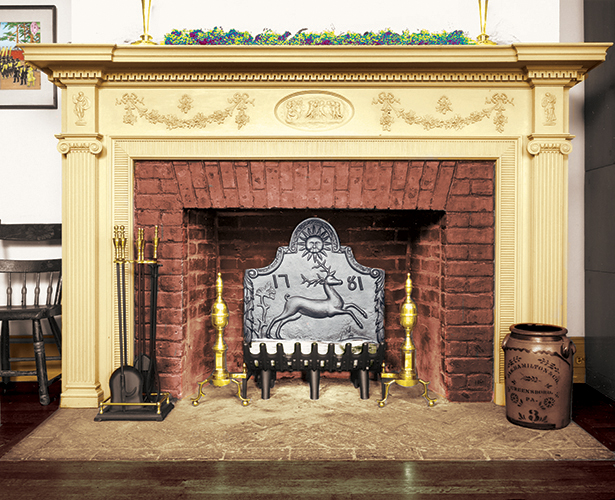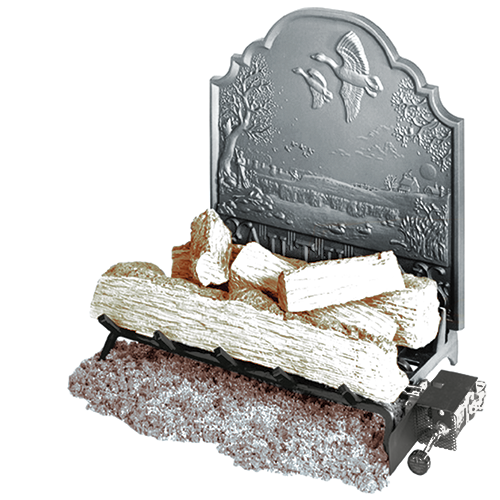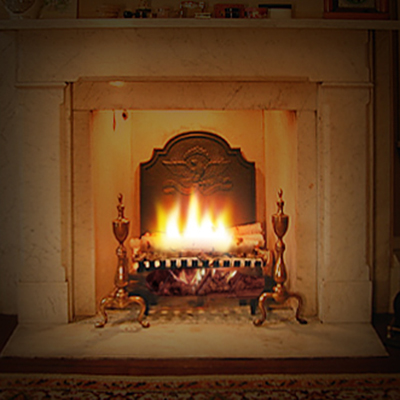

All About The Firebacks
The Art of Warming
In earlier times, the well appointed fireplace was never considered complete unless it included a cast iron fireback. Today, the fireback's usefulness and charms have been rediscovered, and are again at the center of hearth and home.
Positioned against the back wall of the hearth, a fireback protects the masonry of the wall and radiates the heat of the fire forward.
By reflecting light and heat from the fire out into the room, a fireback is a noticeable improvement to a hearth. This warmth is gained whether a fireback is used with wood fires or remote controlled gas log units.
A cast iron fireback is still the best way to protect a hearth's back wall from decay. Despite advances in technology, the harsh rays of fire render even modern refractory materials vulnerable to damage and the likelihood of expensive repairs. A fireback will effectively prevent any further damage to the back wall. If the back wall is already crumbling a fireback will prevent any further deterioration.
As a sculptural accent in what is usually the natural focal point of a home, a fireback lends visual warmth and interest to a hearth whether its with a roaring fire, or by soft candlelight.
In 1979, Pennsylvania Firebacks, revitalized this all but forgotten art form with the introduction of original firebacks made for contemporary fireplaces. Elegant design and castings of heirloom quality are the hallmarks of this unique collection.
Pennsylvania Firebacks is also proud to offer its collection of beautifully detailed museum quality reproductions of antique firebacks. Honored with an award for technical excellence following the premier of this collection, Pennsylvania Firebacks leads the way in bringing the best of the past into the future.

Choosing & Using A Fireback
Choosing a fireback for your hearth is a combination of aesthetics and space considerations. A fireback should be at least wide enough to shield the hearth wall directly behind the fire. It is not uncommon for there to be some of the back wall exposed on either side of a fireback. Generally, the height of the fireback should not exceed the height of the fireplace's front opening.
The first thing to do in choosing a fireback is to measure the width of the back wall, the height of the back wall from the floor to the damper or flue, the depth of the hearth from the back wall to the front of hearth, and the width and depth of the grate or andirons that will be used.
If the back wall is perpendicular to the floor (90º), as are many old hearths, a fireback can be simply placed on the floor and leaned against the back wall. If this is done, it is imperative that thin spacers (slate, tile, bolts, thin bricks, etc.) be placed between the back wall and the back of the fireback to insure proper balance is always maintained. This will lessen the depth available for your grate by the thickness of the fireback and the spacer.
Many modern hearths have a back wall that leans slightly forward either from the floor or from a few brick courses above it. In this case our Saf-T-Boot support system can be used to hold the fireback leaning forward at an angle.
If Saf-T-Boots are used, they will raise the height of the fireback between two to three inches, depending on the fireback and the steps it will fit on. The angle of the fireback leaning forward depends on which steps can be used, and where the Saf-T-Boot's support walls are positioned against the fireback. If the Saf-T-Boots support walls are placed in from the border, or edge of the fireback, it will give more of an angle than if placed on the frame or border of the fireback. If less of an angle is needed, placing shims or spacers (small “L” brackets from a hardware store work well) between the fireback and the Saf-T-Boot's support walls. The top of the fireback should be close to, if not touching the back wall.
Saf-T-Boots will bring the back of the fireback, at the bottom, out about 1” from the back wall. This, plus the thickness of the fireback, will lessen the depth available for your grate. The front part of the Saf-T-Boots, beginning at 3 1/2” from the back wall, are 1 1/2” tall and extend 4 1/2” into the hearth. This section of the Saf-T-Boots are designed to fit under most grates.
Pennsylvania Firebacks are dipped into a vat of water base black paint to prevent rust in storage and transit. It is not intended to be a display finish. Some streaking, bubbles or unpainted areas may occur. To give an attractive, brighter finish to the fireback and to protect the casting from rust, an application of water base graphite Stove Polish or Stove Black is recommended. Applied with a toothbrush or rag, this paste when dry can be polished with a wire brush or rag giving the fireback an attractive sheen. This graphite finish is durable and can be re-polished in place after many uses without reapplying the polish.
Do not use a Pennsylvania Fireback with a fire fueled by coal. Do not use a Pennsylvania Fireback with a Wall of Fire type grate.

Focus on the Fireplace
The fireplace is the natural focal point of a home. The fireplace has retained this status even while its role in the day-to-day battle against the elements was supplanted long ago by central heating. You may appreciate the subliminal soundness of this statement when you consider that the word focus itself is derived from the fireplace.
focus, (Latin use) a fireplace, a hearth.
1. (modern use introduced by the astronomer Johannes Kepler in 1604)
In optics, a point at which rays of light that originally diverged from one point meet again, or a point from which they appear to proceed.
2. Figuratively (with a consciousness of the classical Latin meaning), a central or gathering point, like the fire or hearth of a household; the point at or about which anything is concentrated; a center of interest or attraction.
Definition taken from The Century Dictionary, Published by The Century Co., New York, 1906
A fireplace has the ability to convey a feeling of comfort and focus to a room even when not being used. When used, the pleasurable warmth of a fireplace certainly renders it the focus of the room. Decorative opportunities alone insure that the hearth will remain an important part of the home in the future.
Within the fireplace itself, a sculpted cast iron fireback occupies the ultimate focal point. Whether with a glowing wood fire or gas log fire, the soft flicker of candles, or as a backdrop for a display of flowers, firebacks have provided an artistic accent to hearth and home since the fifteenth century. Pennsylvania Firebacks is proud to have revitalized this art form with its introduction of the first American firebacks sculpted in modern times.
Apart from its artistic appeal, it was the fireback’s utilitarian functions that led to the production of our first firebacks during the historic oil crisis of 1979. Protecting a hearth’s vulnerable masonry from decay while radiating the fire’s intense heat into the room a fireback remains a practical addition to any fireplace. If a hearth is already deteriorated, a fireback effectively screens an unsightly back wall and prevents further damage.
Cast to last, a fireback can be a family heirloom that ties generations together around hearth and home.